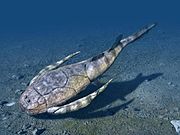
Kronosaurus is an extinct genus of short-necked pliosaurs that lived during the Early Cretaceous period in what is now Australia. It is a monotypic genus with one species K. queenslandicus, described in 1924 from the Toolebuc Formation in Queensland, Australia. With traditionally attributed fossils indicating a total length of up to 10 meters (33 ft), Kronosaurus may have been among the largest pliosaurs.

Villa de Leyva, also called Villa de Leiva, is a touristic colonial town and municipality, in the Ricaurte Province, part of the Boyacá Department of Colombia. The town is a Colombian National Heritage Town and is on the tentative list for UNESCO World Heritage Sites. Villa de Leyva is located 37 kilometres (23 mi) west of the departmental capital Tunja. It is about three hours by car or bus from Bogotá.

Acanthohoplites is an extinct genus of ammonites in the family Parahoplitidae that lived in the Aptian and Early Albian stages of the Early Cretaceous.

Sáchica is a municipality of Colombia situated approximately 34 km (21 mi) west of Tunja in the Ricaurte Province of the department of Boyacá. Sáchica borders Sutamarchán and Villa de Leyva in the north, in the east Chíquiza, Samacá and Ráquira in the south and in the west Ráquira and Sutamarchán. Sáchica is known as the national capital of onions.
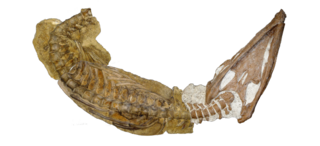
Brachauchenius is an extinct genus of pliosaurid that lived in North America and Morocco during the Late Cretaceous.

Callawayasaurus is a genus of plesiosaur from the family Elasmosauridae. When the holotype was first described by Samuel Paul Welles in 1962, it was described as Alzadasaurus colombiensis before being moved into its current genus by Kenneth Carpenter in 1999.
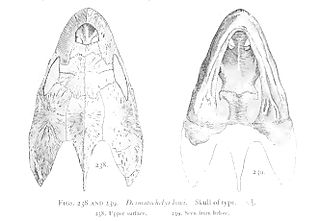
Desmatochelys is an extinct genus of sea turtles belonging to the family Protostegidae. This genus contains two known species, D. lowii and D. padillai. D. lowii was first discovered in 1895, followed by D. padillai in 2015. Having been estimated at over 120 million years old, D. padillai is currently the oldest known species of sea turtle.

Aristonectes is an extinct genus of large elasmosaurid plesiosaurs that lived during the Maastrichtian stage of the Late Cretaceous. Two species are known, A. parvidens and A. quiriquinensis, whose fossil remains were discovered in what are now Patagonia and Antarctica. Throughout the 20th century, Aristonectes was a difficult animal for scientists to analyze due to poor fossil preparation, its relationships to other genera were uncertain. After subsequent revisions and discoveries carried out from the beginning of the 21st century, Aristonectes is now recognised as the type genus of the subfamily Aristonectinae, a lineage of elasmosaurids characterized by an enlarged skull and a reduced length of the neck.
Morturneria is an extinct genus of plesiosaur from the Late Cretaceous of what is now Antarctica.
Orophosaurus is an dubious genus of elasmosaurid plesiosaur from the Late Cretaceous of New Mexico.

The Paja Formation is an Early Cretaceous geologic formation of central Colombia. The formation extends across the northern part of the Altiplano Cundiboyacense, the Western Colombian emerald belt and surrounding areas of the Eastern Ranges of the Colombian Andes. In the subsurface, the formation is found in the Middle Magdalena Valley to the west. The Paja Formation stretches across four departments, from north to south the southernmost Bolívar Department, in Santander, Boyacá and the northern part of Cundinamarca. Well known fossiliferous outcrops of the formation occur near Villa de Leyva, also written as Villa de Leiva, and neighboring Sáchica.

Padillasaurus is an extinct genus of titanosauriform sauropod known from the Early Cretaceous Paja Formation in Colombia. It contains a single species, Padillasaurus leivaensis, known only from a single partial axial skeleton. Initially described as a brachiosaurid, it was considered to be the first South American brachiosaurid ever discovered and named. Before its discovery, the only known brachiosaurid material on the continent was very fragmentary and from the Jurassic period. However, a more recent study finds it to be a basal somphospondylan.
Muiscasaurus is an extinct genus of ophthalmosaurid Ichthyosaur that lived in modern Colombia during the Early Cretaceous. The only known species is the type Muiscasaurus catheti.
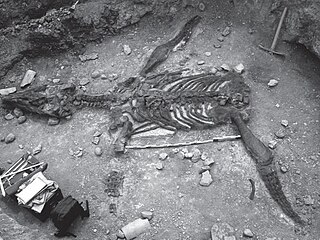
Stenorhynchosaurus is an extinct genus of pliosaurid plesiosaurs which lived in the Early Cretaceous of South America. The type species and only known is Stenorhynchosaurus munozi. It was a medium-sized pliosaur, reaching an adult body length of 7 m (23 ft).
María Euridice Páramo Fonseca is a Colombian paleontologist and geologist. She has contributed to paleontology in Colombia in the fields of describing various Cretaceous reptiles, most notably the mosasaurs Eonatator and Yaguarasaurus, the ichthyosaur Kyhytysuka, and the plesiosaurs Leivanectes and Stenorhynchosaurus.

Leyvachelys is an extinct genus of turtles in the family Sandownidae from the Early Cretaceous of the present-day Altiplano Cundiboyacense, Eastern Ranges, Colombian Andes. The genus is known only from its type species, Leyvachelys cipadi, described in 2015 by Colombian paleontologist Edwin Cadena. Fossils of Leyvachelys have been found in the fossiliferous Paja Formation, close to Villa de Leyva, Boyacá, after which the genus is named. The holotype specimen is the oldest and most complete sandownid turtle found to date.

Acostasaurus is an extinct genus of possibly Thalassophonean pliosaurid known from the Barremian of the Paja Formation, Colombia. The type specimen, UNDG R-1000, is known from a near complete skull, and postcranial elements including a complete hindlimb and various vertebrae. The specimen has an estimated size of over 4 metres (13 ft) in length.

Sachicasaurus is an extinct genus of brachauchenine pliosaurid known from the Barremian of the Paja Formation, Altiplano Cundiboyacense in the Colombian Eastern Ranges of the Andes. The type species is S. vitae.
The Bulldog Shale is a formation of Early Cretaceous age that forms part of the Marree Subgroup of the Rolling Downs Group, located in the Eromanga Basin of South Australia, Queensland and New South Wales.
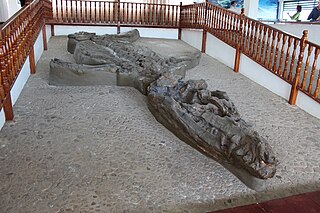
Monquirasaurus is an extinct genus of giant short-necked pliosaurs who lived during the Early Cretaceous (Aptian) in what is now Colombia. One species is known, M. boyacensis, described in 2021 from an almost complete fossil skeleton, discovered in 1977 in the town of Villa de Leyva, located in Boyacá. Published descriptions of the holotype specimen estimate that it should reach a total size approaching 8 m (26 ft) in length, making Monquirasaurus a large representative of the pliosaurids.
























